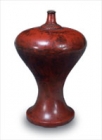Japanese Gallery (Honkan) Room 13
March 24, 2009 (Tue) - June 7, 2009 (Sun)
During the middle ages, many of the furnishings and utensils used in temples and shrines were coated with red lacquer. These objects are known today as negoro-nuri. Whilst one theory suggests that negoro-nuri was first produced during the Kamakura period (1192-1333) by priests who had transferred from Mt. Koya to Negoroji temple in Kii province (present-day Wakayama prefecture), it is known that red lacquerware was actually already in use during the Heian period (794-1192). Hence, it is more probable that the term "negoro-nuri" itself, originally used to refer to red lacquerware produced at Negoroji temple, gradually evolved to refer to red lacquerware in general.
Negoro-nuri wares are characterized by coatings of black lacquer beneath their red-lacquered surface. Over many years of use, the red lacquer wears away, partially exposing the black lacquer underneath. As the lacquer deteriorates, fine cracks additionally appear in the surface, resulting in a unique weathered appearance that can only be achieved with time.
As practical tools crafted with their usage in mind, the simple, clean shapes of negoro-nuri wares paradoxically exhibit a modern sensibility.

